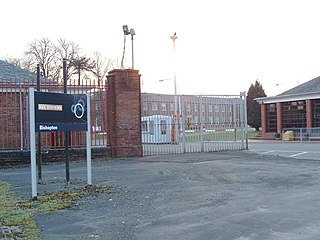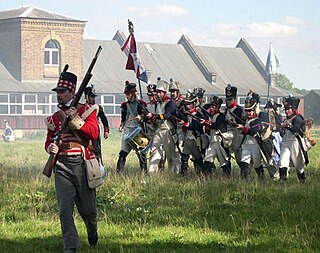Related Research Articles

RDX (abbreviation of "Research Department eXplosive" or Royal Demolition eXplosive) or hexogen, among other names, is an organic compound with the formula (CH2N2O2)3. It is white, odorless and tasteless, widely used as an explosive. Chemically, it is classified as a nitroamine alongside HMX, which is a more energetic explosive than TNT. It was used widely in World War II and remains common in military applications.

Cordite is a family of smokeless propellants developed and produced in Britain since 1889 to replace black powder as a military firearm propellant. Like modern gunpowder, cordite is classified as a low explosive because of its slow burning rates and consequently low brisance. These produce a subsonic deflagration wave rather than the supersonic detonation wave produced by brisants, or high explosives. The hot gases produced by burning gunpowder or cordite generate sufficient pressure to propel a bullet or shell to its target, but not so quickly as to routinely destroy the barrel of the gun.

Royal Ordnance Factory (ROF) Bridgwater was a factory between the villages of Puriton and Woolavington in the Sedgemoor district of Somerset, England that produced high explosives for munitions. It was slightly above sea level, between the 5-and-10-metre contour lines on Ordnance Survey maps. BAE Systems closed it when decommissioning was completed in July 2008.

Bishopton (/bɪʃəptən/) is a village in Renfrewshire, Scotland. It is located around 2 miles (3 km) west of Erskine.
An explosive ROF was a UK government-owned Royal Ordnance Factory (ROF), which specialised in manufacturing explosives during and after World War II. In World War I, the name used in the UK for government-owned explosives factories was National Explosives Factory; the cordite factory at Gretna was known as HM Factory, Gretna.

Royal Ordnance Factories (ROFs) were munitions factories run by the UK government during and after the Second World War. The three main types of factories were engineering, filling and explosives, and these were dispersed across the country for security reasons. ROFs were the responsibility of the Ministry of Supply and later the Ministry of Defence until privatisation in 1987.
ROF Thorp Arch was one of sixteen Second World War, UK government-owned Royal Ordnance Factory, which produced munitions by "filling" them. It was a medium-sized filling factory.
A filling factory was a manufacturing plant that specialised in filling various munitions, such as bombs, shells, cartridges, pyrotechnics, and screening smokes. In the United Kingdom, during both world wars of the 20th century, the majority of the employees were women.
Royal Ordnance Factory (ROF) Elstow was one of sixteen UK Ministry of Supply, World War II, Filling Factories. It was a medium-sized filling factory, Filling Factory No. 16, which filled and packed munitions. It was located south of the town of Bedford, between the villages of Elstow and Wilstead in Bedfordshire. It was bounded on the northeast by the A6 and on the west by a railway line. Hostels were built nearby to accommodate the workers who were mostly female.

The Royal Ordnance Factory (ROF) Bishopton was a WW2 Ministry of Supply Explosive Factory. It is sited adjacent to the village of Bishopton in Renfrewshire, Scotland. The factory was built to manufacture the propellant cordite for the British Army and the Royal Air Force. It also later produced cordite for the Royal Navy. The Ministry of Works were responsible for the site. It was the biggest munitions factory the MOD had, with up to 20,000 workers.
A World War I explosive factory, which was to be later known as NEF Pembrey was built, by Nobel's Explosives, with British Government approval, near the village of Pembrey, Carmarthenshire, Wales. The factory was built on a site consisting of mainly sandhills and sand dunes to provide some protection against damage caused by an explosion. Its main product was TNT (Trinitrotoluene) used for shell filling. The same site was used in World War II to build another explosive factory ROF Pembrey, which also made TNT.

Wrexham Industrial Estate is a well defined industrial area in Wrexham. It is sited on the eastern outskirts of the city and 3 miles from the centre of Wrexham.

ROF Chorley was a UK government-owned munitions filling Royal Ordnance Factory. It was planned as a permanent Royal Ordnance Factory with the intention that it, unlike some other similar facilities, would remain open for production after the end of World War II; and, together with ROF Bridgend, would replace the Royal Filling Factory located at the Royal Arsenal, Woolwich. It was built largely in Euxton, but was known as ROF Chorley.

Ranskill is a village and civil parish in the Bassetlaw district of Nottinghamshire, England, with its nearest town being Retford approximately 5 miles south. The Ranskill parish according to the 2001 census has 2,226 residents, falling to 1,362 at the 2011 census, and improving to 1,435 at the 2021 census. There is also a Bassetlaw ward called Ranskill. This ward had a population of 2,417 at the 2011 census.

Caerwent Training Area is a British military installation at Caerwent, Monmouthshire, Wales. The large military site is situated north of the A48 road about 5 mi (8.0 km) west of Chepstow and 12 miles (19 km) east of Newport.

The Royal Naval Cordite Factory, Holton Heath (RNCF) was set up at Holton Heath, Dorset, England, in World War I to manufacture cordite for the Royal Navy. It was reactivated in World War II to manufacture gun propellants for the Admiralty and its output was supplemented by the Royal Navy Propellant Factory, Caerwent. After the end of World War II, the explosive manufacturing areas of the site were closed down and some areas of the site reopened as the Admiralty Materials Laboratory. A major part of the explosives site became a nature reserve in 1981. Other parts of the site were converted into an industrial estate; and some may be used for housing.

The Royal Gunpowder Mills are a former industrial site in Waltham Abbey, England. It was one of three Royal Gunpowder Mills in the United Kingdom. Waltham Abbey is the only site to have survived virtually intact.
Royal Ordnance plc was formed on 2 January 1985 as a public corporation, owning the majority of what until then were the remaining United Kingdom government-owned Royal Ordnance Factories which manufactured explosives, ammunition, small arms including the Lee–Enfield rifle, guns and military vehicles such as tanks. It owned some 16 factories; and employed about 19,000 staff.
National Filling Factory, Banbury, officially called National Filling Factory No. 9. was a British Ministry of Munitions filling factory, constructed during World War I and located in Banbury, Oxfordshire. The production of filled shells began in April 1916 and ended when the factory closed in 1924

The Grangeston Halt railway station was a private station that was not listed in the public timetables, located in a rural part of South Ayrshire, Scotland and served the WWII Grangeston ICI munitions plant bringing workers to the site. Grant's Distillery now occupies much of the site.
References
- 1 2 Hornby 1958, p. 118.
- ↑ Cocroft 2000, pp. 206–207.
- 1 2 Hornby 1958, p. 119.
- ↑ Cocroft 2000, p. 237.
Sources
- Cocroft, Wayne (2000). Dangerous Energy: The Archaeology of Gunpowder and military explosives manufacture. Swindon: English Heritage. ISBN 978-1-85074-718-5.
- Hornby, William (1958). Factories and Plant. History of the Second World War: United Kingdom Civil Series. London: Her Majesty's Stationery Office and Longmans, Green and Co. OCLC 903565789.